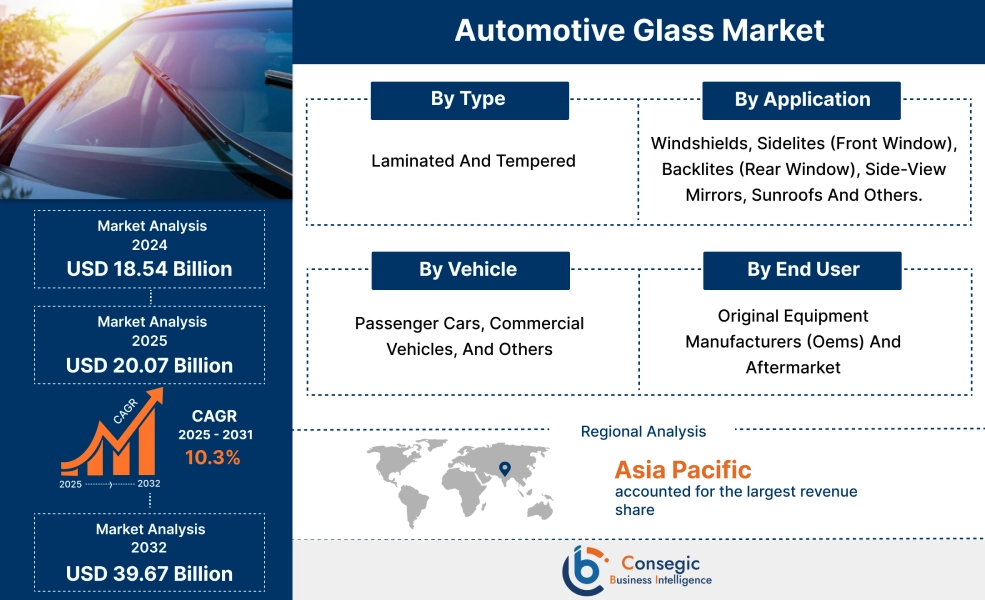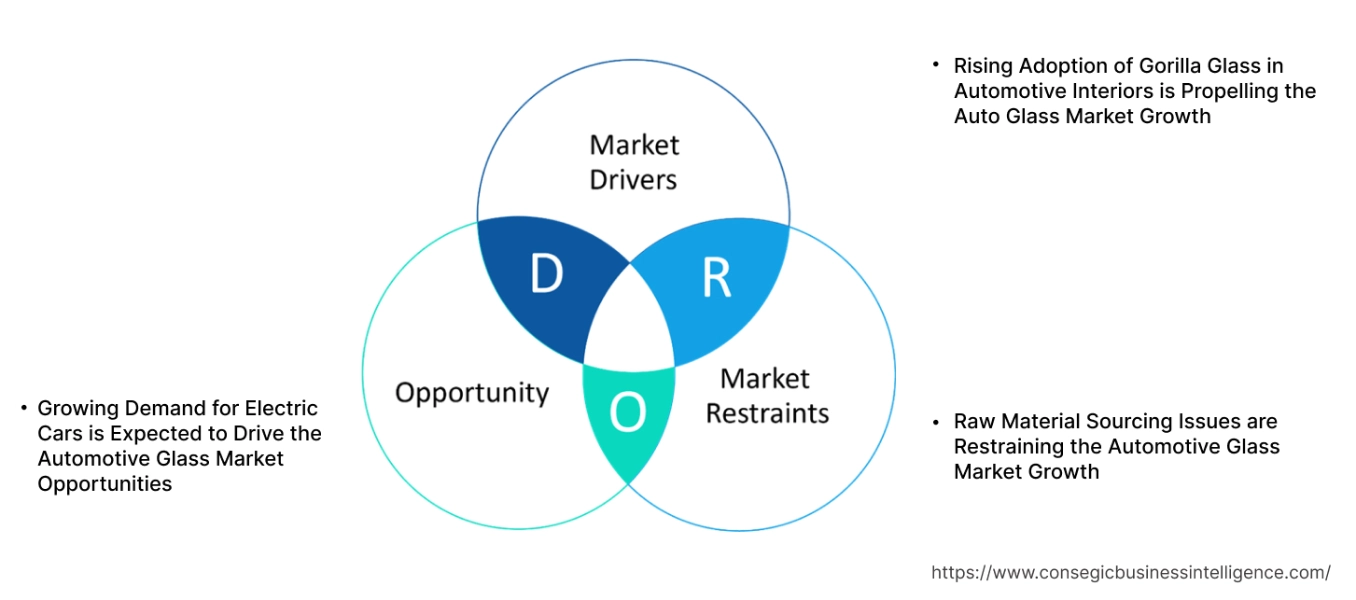Automotive Glass Market Size:
The Automotive Glass Market is estimated to reach over USD 39.67 Billion by 2032 from a value of USD 18.54 Billion in 2024 and is projected to grow by USD 20.07 Billion in 2025, growing at a CAGR of 10.3% from 2025 to 2032.
Automotive Glass Market Scope & Overview:
Automotive glass refers to the glass used in vehicles to protect the car from the weather, rain, fog, and the sun. The different types of glass used in an automobile are windshields, back glass, side windows, and sunroofs. Automotive glass differs from ordinary glass because it is safer and offers more features than regular glass. Automobiles typically are subject to a lot of different weather conditions, wind, speed bumps on roads, and potholes, which make the use of regular glass risky. Further, the trends, including an increase in car ownership, the importance of safety in cars, and a growing urban population, have fueled the market. Furthermore, there is a growing need to keep the inside of a vehicle safe during collisions and accidents, which in turn drives the market.
How is AI Transforming the Automotive Glass Market?
The integration of AI is significantly transforming the automotive glass market. AI-powered systems are being used for enhancing various aspects, including design, manufacturing, and quality control processes during the fabrication of glass. In addition, AI-driven automation enhances efficiency and reduces human error in production processes.
Further, AI-powered quality control systems can identify defects in real-time, in turn ensuring higher quality standards and reducing waste. AI solutions can also analyze data from machine sensors to predict potential issues and schedule maintenance, thereby minimizing downtime and optimizing production. Therefore, the aforementioned factors are expected to drive the market growth in upcoming years.
Automotive Glass Market Dynamics - (DRO) :
Key Drivers:
Rising Adoption of Gorilla Glass in Automotive Interiors is Propelling the Auto Glass Market Growth
Glass used in automobiles has witnessed technological advancements due to the integration of Gorilla Glass in the interiors of a vehicle. Gorilla glass used in the interior of a vehicle is typically more durable, lighter, and offers better optical clarity. Further, the increasing use of Gorilla Glass in cars due to the inclusion of anti-reflective films is also driving the automotive glass market share.
- For instance, Corning offers auto glass for use in the interior of vehicles with a surface treatment suite that includes anti-reflective films and coatings. The films and coating help in delivering better display performance and smooth touch and feel.
Hence, the growing adoption of Gorilla Glass in the interiors of vehicles due to better durability and optical clarity is driving the automotive glass market size.
Key Restraints:
Raw Material Sourcing Issues are Restraining the Automotive Glass Market Growth
Many raw materials are used in the production of automotive glass, like soda ash and raw sand. Silica sand, which is a type of sand, is made up of elements including silica and oxygen. Ordinary sand also contains silica, but it often has other impurities, making it unsuitable for use in the production of automotive glass. The mining of silica sand is destructive to environments and natural habitats. Further, with the growing emphasis on environmental regulations due to increased awareness among the people, silica sand may see a decrease in supply, which in turn will increase the prices. Thus, the raw material sourcing issues for silica sand pose a threat to the automotive glass market expansion.
Future Opportunities :
Growing Demand for Electric Cars is Expected to Drive the Automotive Glass Market Opportunities
Electric car adoption has been on the rise due to the advancements in the technology used in cars and the overall safety of cars. The growing demand for electric cars offers an opportunity for the auto glass market to grow as electric cars use various types of auto glass, including smart glass for improved safety and comfort. Electric cars offer an environmentally friendly alternative to ICE cars, considering the CO2 emissions of ICE cars are harmful to the environment.
- For instance, according to the IEA, nearly one in five cars sold in 2023 was electric. The growing adoption of electric cars is expected to boost the auto glass market as electric cars use lighter smart glass to achieve energy efficiency.
Thus, the rise in electric vehicles due to less CO2 emissions and improved safety will likely fuel the automotive glass market opportunities.
Automotive Glass Market Segmental Analysis :
By Type:
Based on the type, the market is segmented into laminated and tempered.
Trends in the type:
- Tempered glass has witnessed growing adoption due to the fact that it shatters into small pieces, reducing the risk of serious cuts.
- Many lawmakers today require car manufacturers to use laminated glass for windshields, as it can withstand high impact, driving the automotive glass market trends.
Tempered accounted for the largest revenue share in the year 2024.
- Tempered glass has many uses in a car, like side view mirrors and side windows.
- In terms of production, tempered glass is cheaper to produce than laminated glass, making it widespread for use in the interior and exterior of vehicles.
- Many companies opt to make their side mirrors and backlites with tempered glass due to its low cost and safety measures, which in turn drive the market.
- For instance, AIS glass offers Temperlite-LT, a tempered glass manufactured for use in backlites of the car. The glass offers features like higher temperature tolerance and breaking into blunt, round pieces for enhanced safety during a collision. The glass is also about four times stronger than annealed glass, which increases its ability to withstand high impact.
- Thus, the adoption of tempered glass due to cheap production and rising use in the interior of vehicles is driving the automotive glass market growth during the forecast period.
Laminated is anticipated to register the fastest CAGR during the forecast period.
- Laminated glass has experienced huge adoption in automobiles in recent times due to its safety, especially during collisions and accidents.
- Many car manufacturers in the luxury space prefer using lamented glass for front and back windows due to the fact that it does not break or shatter into tiny pieces.
- Laminated glass also offers a quieter space inside cars, owing to the fact that it reduces the noise coming from outside.
- For instance, Jaguar I-Pace features an acoustic laminated glass in its front window and windshield to offer a quieter driving experience to its customers.
- Therefore, increasing use of laminated glass in luxury cars is driving the overall market during the forecast period.
By Application:
Based on the application, the market is segmented mainly into windshields, sidelites (front window), backlites (rear window), side-view mirrors, sunroofs and others.
Trends in the application:
- Technological advancements in windshields, like the integration of head-up displays and augmented reality, are driving the market.
- Factors like improved air circulation and visual appeal due to sunroofs are driving the automotive glass market trends.
Windshields accounted for the largest revenue share in the year 2024.
- The growing need for cars to offer safety to passengers has driven the windshield segment to grow at a robust rate.
- Technological advancements like tinted windshield films made from SPD smart glass to block incoming light are driving the segment.
- Many manufacturers have started integrating features like heating elements between layers of glass to improve the visibility of drivers in cold weather conditions.
- For instance, Skoda offers a heated windscreen in the Skoda Octavia to protect the windscreen from the buildup of ice in cold weather.
- Therefore, the increasing trend of utilization of auto glass in windshields due inclusion of tinted films and heating elements is propelling the market growth.
Sunroofs are anticipated to register the fastest CAGR during the forecast period.
- Car manufacturers today are increasingly focusing on integrating sunroofs in their cars due to the improved and immersive experience offered to the drivers.
- Sunroofs in cars offer enhanced driving pleasure to the driver due to the presence of natural light, which gives the interior an expansive feel.
- Modern sunroofs can be automatically operated through remotes or buttons in the car, making the operation hands-free.
- For instance, Webasto recently announced the opening of a new sunroof plant facility in India and plans to produce close to 950000 sunroof units by 2027, owing to the growing demand.
- Hence, the growing sunroof market is projected to drive the automotive glass market during the forecast period.
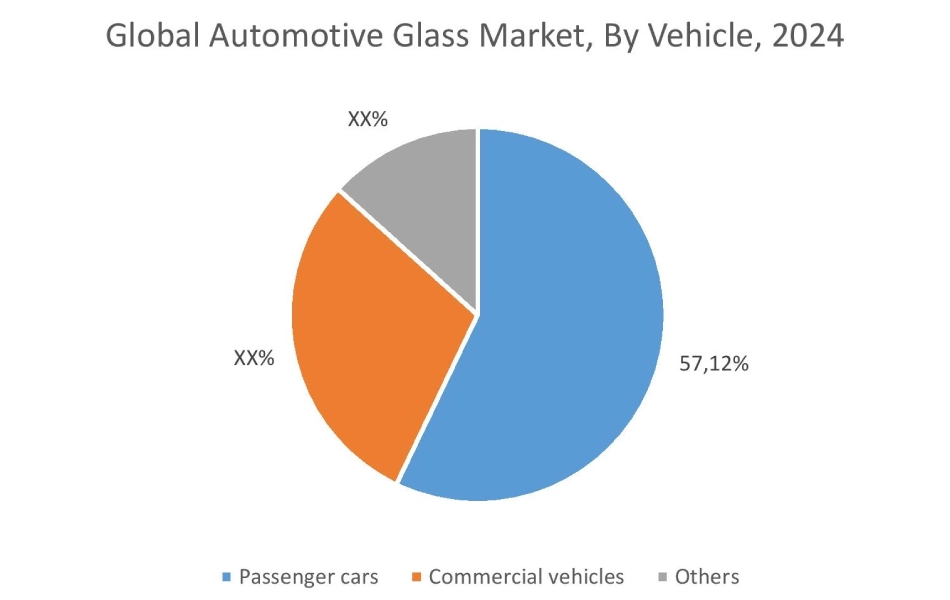
By Vehicle:
Based on the vehicle, the market is segmented into passenger cars, commercial vehicles, and others.
Trends in the vehicle:
- Global car sales have experienced a robust increase in sales in emerging regions like Asia, fueling the automotive glass market size.
- Commercial vehicles like trucks and buses have also experienced growing demand due to the growing logistics sector, which has driven the auto glass market.
Passenger cars accounted for the largest revenue share of 57.12% in the year 2024 and are anticipated to register the fastest CAGR during the forecast period.
- Many companies today are incorporating different types of auto glasses, such as UV protection glass that protects the driver from high temperatures and eye strain.
- Defogger glass in cars helps in combating condensation using the car’s heating system to prevent moisture buildup, which is driving the segment.
- Glasses with certain features, like rain sensors, help in freeing the driver from manual operation during rainfall.
- For instance, AIS offers auto glass with certain value-added glasses like AIS IR + UV shield and a windscreen with rain sensors. The rain sensors can detect the volume of rain on the windscreen and automatically adjust the speed of the wipers.
- Therefore, the rising utilization of defogger glass and UV glass in passenger cars is propelling the automotive glass market.
By End User:
Based on the end user, the market is segmented into original equipment manufacturers (OEMs) and aftermarket.
Trends in end users:
- OEMs use auto glass for side windows and sliders in pick-up trucks, driving the automotive glass market share.
- Aftermarket sellers have started integrating the Advanced Drive-Assistance System (ADAS) within their windshields, which in turn drives the market.
Original Equipment Manufacturers (OEMs) accounted for the largest revenue share in the year 2024.
- OEMs have experienced rising adoption of auto glass due to the different types of sensors being integrated with the glass, like sensors that expand and contract during heat.
- OEMs have witnessed a rising trend for adoption of windshields that offer resistance during collisions, UV protection, acoustic glass, and water-repellent technologies, as per the analysis.
- Increased emphasis by OEMs to reduce the weight of the glass for better energy efficiency and reduced emissions due to reduced weight of the vehicle is driving the market.
- For instance, according to the EPA, a passenger vehicle emits approximately 4.6 metric tons of carbon dioxide every year. The reduced weight of auto glass can help in achieving fuel efficiency, resulting in decreased carbon emissions.
- Thus, the growing adoption of glasses with acoustic and water-repellent features for improved safety is driving the automotive glass market.
Aftermarket is anticipated to register the fastest CAGR during the forecast period.
- Automotive aftermarket sellers offer cheaper alternatives for car parts, including auto glass, which in turn drives the market.
- In developing countries, the automotive aftermarket offers cheaper and often reliable alternatives for end consumers, in turn driving the market.
- The aftermarket sellers have experienced a considerable increase in sales in recent times due to growing car sales and growth in e-commerce platforms offering B2C parts and information related to auto glass, as per the automotive glass market analysis.
- For instance, Glavista offers manufacturing and distribution of premium-quality auto glass within a short time, catering to both the OEMs and the aftermarket.
- Hence, as per the analysis, the rising adoption of the automotive aftermarket due to an increase in online platforms and the availability of cheaper alternatives has resulted in the automotive glass market expansion during the forecast period.
Regional Analysis:
The regions covered are North America, Europe, Asia Pacific, the Middle East and Africa, and Latin America.
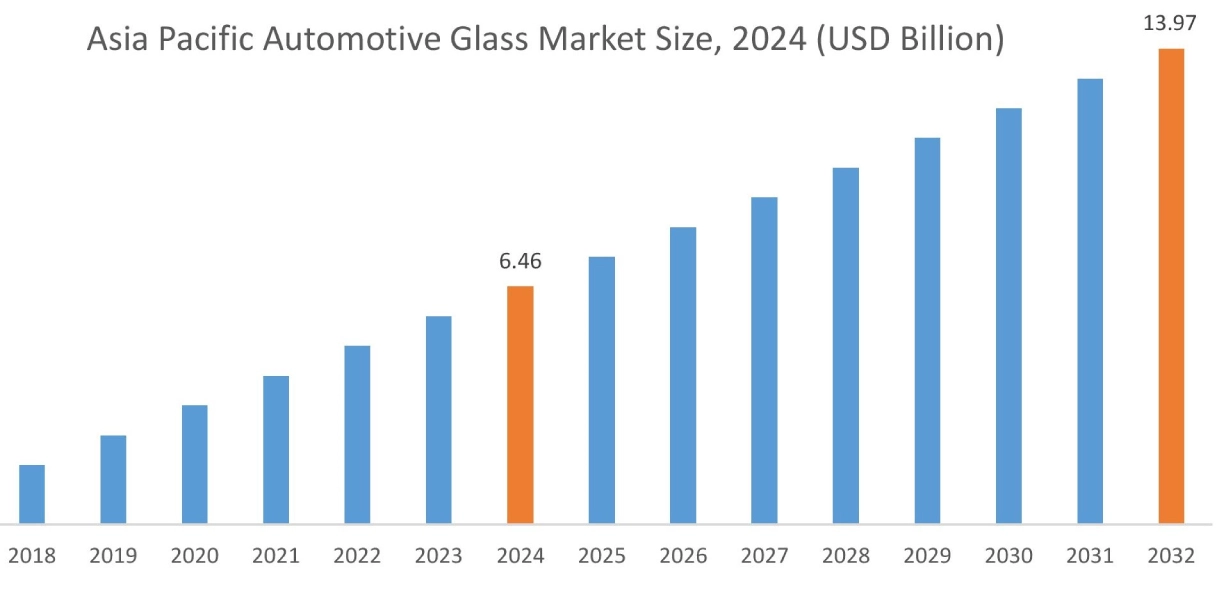
Asia Pacific region was valued at USD 6.46 Billion in 2024. Moreover, it is projected to grow by USD 7.00 Billion in 2025 and reach over 13.97 Billion by 2032. Out of this, China accounted for the maximum revenue share of 37.80%. As per the automotive glass market analysis, the adoption of auto glass in the Asia-Pacific region is primarily driven by the growing commercial vehicles market and car market.. Additionally, the electric vehicles market is further driving the automotive glass market.
- For instance, according to SIAM, the passenger vehicle sales in India stood at approximately 42 million in 2023-24. The increase in passenger vehicle sales will boost the sales of automotive glass.
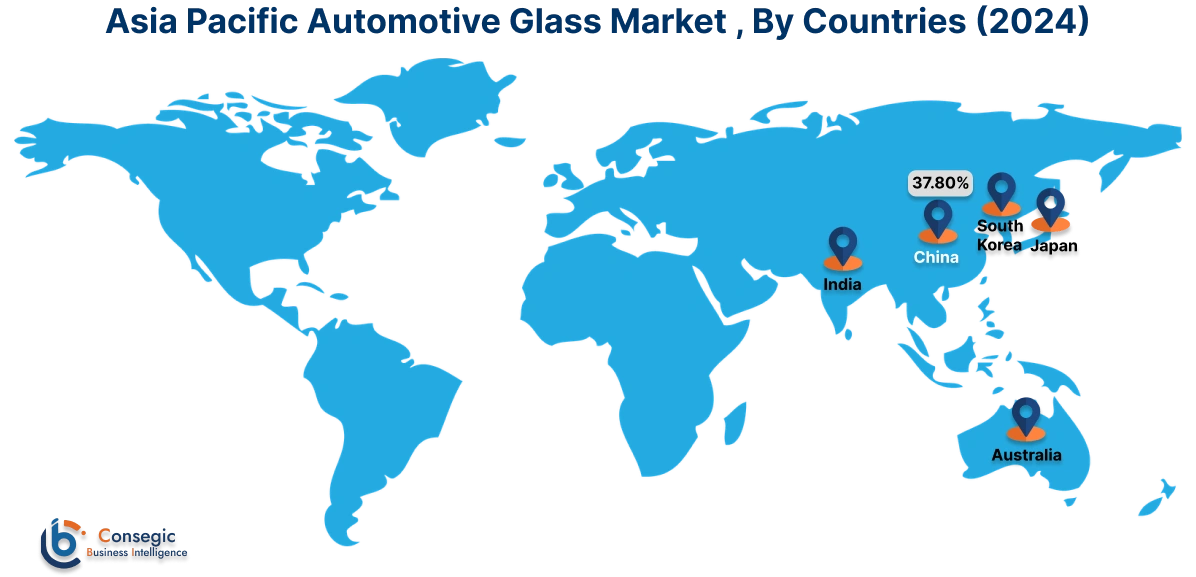
North America is estimated to reach over 11.72 Billion by 2032 from a value of USD 5.44 Billion in 2024 and is projected to grow by USD 5.89 Billion in 2025. In North America, the growth of the automotive glass industry is driven by the growing investments in truck production to transport commodities via roads and the growth in electric vehicles. Moreover, the increasing adoption of auto glass by aftermarket players for selling third-party auto glass to end-consumers and garage services is contributing to the automotive glass market demand.
- For instance, according to the ATA, Trucks were responsible for the movement of approximately 72.6% of America’s freight by weight in 2022. The increasing use of trucks for freight is expected to drive the adoption of auto glass in trucks.
Additionally, the regional analysis depicts that the growing use of auto glass in military vehicles due to an increase in defense spending is driving the automotive glass market in Europe. Furthermore, as per the industry analysis, the automotive glass market demand in Latin America is growing at a considerable rate due to the rising adoption of auto glass for use in sunroofs. Middle East and African regions are expected to grow at a considerable rate due to factors such as the development of plant facilities that manufacture auto glass in the region and the rising adoption of auto glass with value-added features.
Top Key Players and Market Share Insights:
The global automotive glass market is highly competitive, with major players providing glass to the national and international markets. Key players are adopting several strategies in research and development (R&D), product innovation, and end-user launches to hold a strong position in the automotive glass market. Key players in the automotive glass industry include -
- G.C. Inc. (Japan)
- Xinyi Glass Holdings Limited (China)
- Glavista (Germany)
- Vitro (Mexico)
- Guardian Glass Holdings (U.S.)
- Saint Gobain Sekurit (France)
- Fuyao Glass (U.S.)
- Webasto Group (Germany)
- Magna International Inc. (Canada)
- Nippon Sheet Glass Co. Ltd. (Japan)
Recent Industry Developments :
Market Expansion:
- In September 2024, Webasto launched a new high-tech glass production line in a plant in Luxembourg. The new facilities are expected to increase production efficiency by saving on energy consumption.
Product Launch:
- In March 2024, AGC Automotive, a company that manufactures auto glass, unveiled a panoramic vehicle-integrated photovoltaic (VIPV) sunroof for passenger vehicles. The VIPV unit does not require a roller blind system, which helps in saving weight of up to 5 kg.
Automotive Glass Market Report Insights :
| Report Attributes | Report Details |
| Study Timeline | 2019-2032 |
| Market Size in 2032 | USD 39.67 Billion |
| CAGR (2025-2032) | 10.3% |
| By Type |
|
| By Application |
|
| By Vehicle |
|
| By End User |
|
| By Region |
|
| Key Players |
|
| North America | U.S. Canada Mexico |
| Europe | U.K. Germany France Spain Italy Russia Benelux Rest of Europe |
| APAC | China South Korea Japan India Australia ASEAN Rest of Asia-Pacific |
| Middle East and Africa | GCC Turkey South Africa Rest of MEA |
| LATAM | Brazil Argentina Chile Rest of LATAM |
| Report Coverage |
|
Key Questions Answered in the Report
How big is the Automotive Glass market? +
The Automotive Glass market is estimated to reach over USD 39.67 Billion by 2032 from a value of USD 18.54 Billion in 2024 and is projected to grow by USD 20.07 Billion in 2025, growing at a CAGR of 10.3% from 2025 to 2032.
Which is the fastest-growing region in the automotive glass market? +
Asia-Pacific region is experiencing the most rapid growth in the automotive glass market.
What specific segmentation details are covered in the automotive glass market report? +
The automotive glass market report includes specific segmentation details for type, application, vehicle, end user, and region.
Who are the major players in automotive glass market? +
The key participants in the automotive glass market are A.G.C. Inc. (Japan), Saint Gobain Sekurit (France), Fuyao Group (China), Webasto Group (Germany), Magna International Inc. (Canada), Nippon Sheet Glass Co. Ltd. (Japan), Xinyi Glass Holdings Limited (China), Glavista (Germany), Vitro (Mexico), Guardian Glass Holdings (U.S.).
